News about the upgraded SOTEN drone from ACSL dominated the headlines earlier this year, with the flight dynamics and enhanced gimbal and camera controls especially notable to many drone operators. That update called out efforts to optimize the flight controller, but ACSL has taken that optimization to the next level with this week’s announcement of the TENSO, which is a new smart controller that has been designed to increase efficiency for operators in the field.
 Very smooth and reactive, usability was prioritized when designing TENSO. The user interface is clean, simple, and easy to understand, which is critical when working in the field. While the user experience was designed to be much more intuitive, what sort of a practical difference will operators be able to experience on account of this ease of use?
Very smooth and reactive, usability was prioritized when designing TENSO. The user interface is clean, simple, and easy to understand, which is critical when working in the field. While the user experience was designed to be much more intuitive, what sort of a practical difference will operators be able to experience on account of this ease of use?
“One of the strategic things about TENSO is the ability to have more dedicated buttons for common functions,” said Francisco Toro, ACSL Solutions Engineering Manager. “For instance, it's a lot easier for pilots to quickly take pictures and videos when there are dedicated buttons instead of scrolling through menu settings. This is especially true when they need to react quickly and they can rely on muscle memory or even out in the field during inclement weather wearing gloves.”
The built-in, bright screen is easier to use in harsh lighting compared to a mobile device. Operators will also see an increase in efficiency since they only have to charge and handle one thing. The integrated HD display and intuitive user interface further highlight the difference that users will be able to see and experience.
Key upgrades associated with the TENSO smart controller include:
- Reduced Video Latency: Real-time video latency has been reduced 25%, improving the viewing experience for operators.
- Customizable Gimbal Control: New modes and tunable parameters allow pilots to customize gimbal movement according to their input preferences. Additionally, gimbal speed now adjusts automatically based on zoom level for more precise control.
- Direct Exposure Control: Gives pilots, especially those flying inspection missions, the ability to quickly adjust image exposure to reveal details of objects that are hidden in shadows or obscured by a bright background.
- Universal Compatibility: Upgraded the standard controller’s electronics to support a wider range of Android devices.
- US Remote ID Compliance: The SOTEN drone’s firmware is now fully compliant with US remote ID regulations, as accepted by the FAA.
ACSL’s commitment to continuous improvement and innovation isn’t limited to the TENSO though. News about the TENSO also included updates on the roadmap ahead, with upcoming improvements related to swappable payloads, countermeasures against camera vibration, automatic continuation of mapping missions following a battery swap, further real-time video latency reduction and more. Which of these updates will be most impactful to users?
“Quick access for exposure settings and a dedicated shutter button to adjust as needed were critical,” Toro told Commercial UAV News. “With TENSO, operators can easily optimize the pictures taken for inspection and other workflows. The ability to change gimbal speed is really unique and we think pilots will find that’s useful for specific video scenarios. Most importantly, the reduced video latency will bring the most benefits to customers as they operate in conditions that may require quick reactions.”
TENSO will be available for purchase in September as part of select SOTEN operation-ready bundles. To find an authorized dealer, visit ACSL’s dealer locator page.
















Comments